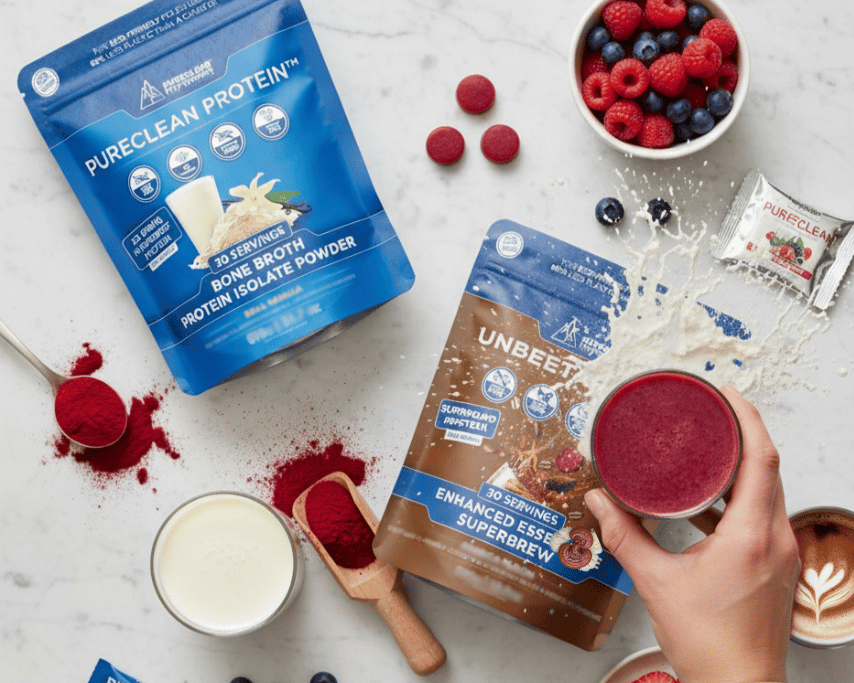
What the Supplement Industry Gets Wrong
Every year new “miracle molecules” promise instant muscle, glowing skin, everlasting life or bulletproof joints. Most ignore basic biochemistry. Your body doesn’t absorb hype or respond well to anything that fights against its own biology. When it comes to protein, it only absorbs amino acids and peptides in precise ratios. Understanding how those work is the key to real recovery and resilience.
1. Protein Is a Signal, Not Just a Calorie Source
Protein isn’t fuel—it’s information. Amino acids trigger mTOR and satellite-cell activity to build or repair tissue. When amino supply matches need, muscle protein synthesis (MPS) rises; when it doesn’t, breakdown wins. Too much unbalanced protein simply becomes urea or glucose.
2. Debunking the Modern Protein Myths
Myth #1 : “More protein = more muscle.”
After ~1.6–1.8 g/kg bodyweight, returns flatten. The body oxidizes surplus amino acids for energy rather than building tissue. Balance and timing beat excess.
Myth #2 : “Collagen builds muscle.”
Collagen lacks key branched-chain and essential amino acids. It can’t drive MPS alone. Its strength lies in providing glycine, proline, hydroxyproline—the raw materials for connective-tissue and joint repair. Combine it with complete protein with muscle tissue aminos and also better in addition to EAAs for potent and lasting effects.
Myth #3 : “Any collagen is the same.”
Collagen benefits depend on peptide size and bioavailability. Hydrolyzed peptides (1–3 kDa) absorb rapidly and stimulate fibroblast activity; large gelatin molecules don’t.
Myth #4 : “Creatine replaces protein.”
Creatine increases phosphocreatine energy turnover; it does not provide structural amino acids. Use it with—but never instead of—complete protein.
3. Why Collagen + Complete Protein Works Better Together
Muscle fibers need EAAs (especially leucine, lysine, methionine).
Tendons, ligaments, fascia rely on glycine, proline, and hydroxyproline from collagen peptides. Did you know that whey and plant proteins do not have these? That's a big problem!!
Skin and cartilage benefit from hydrolyzed protein peptides that signal fibroblasts to produce new collagen.
Stacking collagen with a high-EAA protein blend fills both sides of the repair equation—contractile tissue and connective scaffolding—something single-source proteins can’t do.
4. The Overlooked Variable: Digestibility & Nitrogen Efficiency
Even worse, many whey and plant proteins deliver only 30 % on average net nitrogen utilization (plant proteins are closer to 18% which is terrible comparatively). Hydrolyzed peptides and EAA-balanced formulations can exceed 90 %, meaning less waste, less bloating, and faster repair.
5. Introducing PureClean Protein: Evidence-Based Dual-Matrix Formula
PureClean Protein unites a clean complete-protein base from grass-fed beef muscle tissue with clinical-grade naturally occurring collagen peptides to cover both anabolic and connective-tissue pathways.
- Full-spectrum essential amino acids for MPS and recovery.
- Type I & III hydrolyzed collagen peptides for joint, tendon, and skin resilience.
- High digestibility and protein by volume (>90 %)—no gums, fillers, or artificial sweeteners.
- Supports methylation balance via natural glycine : methionine ratio.
Use it post-training or as a daily rebuild shake. It’s not another “protein bomb”; it’s the complete tissue-repair system your body actually recognizes.
6. Quick FAQ
Is collagen alone enough?
No. It lacks the EAAs required for MPS. Pairing it with complete protein fixes the deficit.
When’s the best time to take it?
Within 30 min post-training or anytime you need a high-quality protein serving.
7. Key Research References
- Tipton KD, Wolfe RR. Protein and amino acids for athletes. J Int Soc Sports Nutr 2013.
- Morton RW et al. Protein intake and resistance training meta-analysis. Br J Sports Med 2018.
- Shaw G et al. Collagen supplementation and connective tissue adaptation. Amino Acids 2019.
- Iwai K et al. Hydrolyzed collagen peptides and absorption kinetics. J Agric Food Chem 2005.
- Persky AM, Rawson ES. Creatine supplementation and skeletal muscle metabolism. Sports Med 2007.
- Volpi E et al. Essential amino acids stimulate muscle protein synthesis. Am J Clin Nutr 2015.
